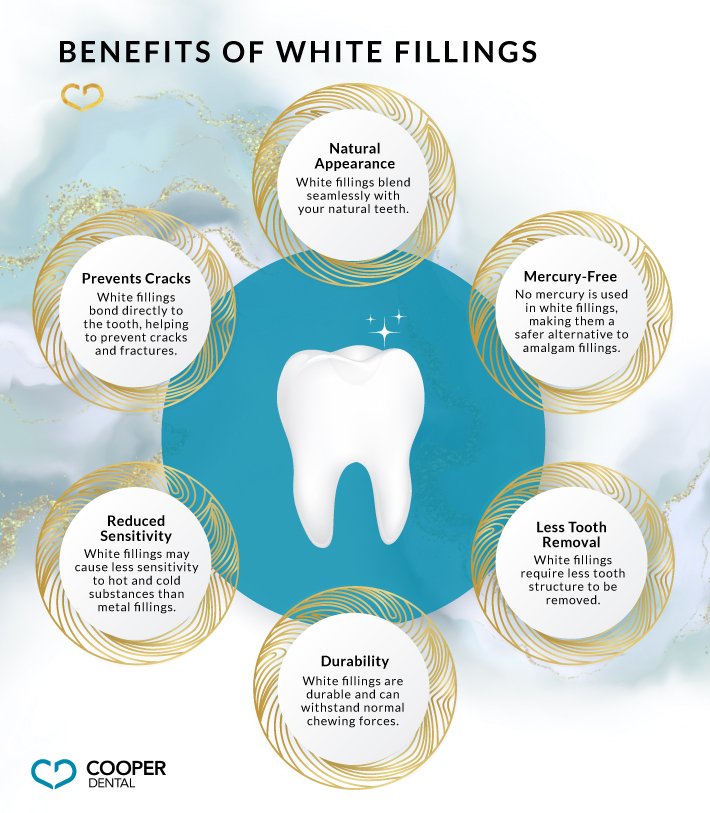In the realm of dental health, technology and medical advancements continuously aim to marry aesthetics with functionality, and white fillings are a result of that. Tailored for dental patients who prioritize both the health and appearance of their smiles, white fillings are revolutionizing tooth restoration practices.
Compared to silver fillings, white fillings can offer benefits such as blending better with your natural teeth, preserving the structural integrity of your smile, and reducing the need for extensive tooth preparation prior to placement. Additionally, white fillings do not contain toxic metals like mercury.
If you are not sure which type of filling is best for you, a good place to start is a checkup with your dentist. Dr. Cooper can walk you through your options and offer advice on what may work well for you and your needs.
What Does a Dental Cavity Look & Feel Like?
When it comes to oral health, identifying dental cavities is crucial. These holes in the teeth, also known as caries or tooth decay, can cause discomfort and lead to more serious dental problems if left untreated.
A dental cavity can manifest in various ways visually. Initially, it may appear as a chalky white area, indicating decalcification—which means the enamel is breaking down and getting soft. Alternatively, a cavity can appear as a dark pinpoint spot.
If left unaddressed, both of these scenarios can result in a larger hole in the tooth. In the beginning stages, there is often no discomfort, but increased awareness, sensitivity, and pain can occur when the bacteria infiltrates the tooth further as the hole is getting bigger. If the hole does in fact get larger, the nerve can be affected and a root canal may be required.
While you should schedule a dental exam if you notice signs of a cavity, keeping up with regular checkups and cleanings is also important. Those routine visits help make it possible for us to identify early signs of a cavity—even before you notice them on your own. Taking annual x-rays is also a great screening tool to diagnose cavities.
Cavity Size & Fillings
The size of the cavity plays a crucial role in determining the most appropriate course of action for treating it. Depending on the extent of decay, different treatment options may be necessary to restore the tooth effectively.
- For small cavities that are detected early, white fillings are often the go-to treatment option. This process helps restore the tooth’s structure and function while preventing further decay. Small cavities are typically limited to the outer enamel or dentin layers.
- Large cavities that have compromised a significant portion of the tooth’s structure may necessitate the use of crowns or onlays for optimal restoration, rather than white fillings. This is because they extend deeper into the tooth and need more support to bring the tooth back to its natural shape. The material used in these cases is also stronger and better suited for managing biting forces.
Types of Dental Fillings
When considering dental fillings, it is crucial to understand the variety available as each type offers distinct advantages and potential drawbacks based on the patient’s needs and the specific tooth’s condition.
- Amalgam Fillings: Also known as silver fillings, amalgam has been used for over a century due to its durability and strength, and at the time, it was the only option for filling material. However, due to their noticeable silver colour, they are less popular for visible teeth and that they contain mercury.
- Composite Fillings: These are white fillings made from a mixture of plastic and fine glass particles, designed to match the natural colour of your teeth. Composite fillings blend in aesthetically and are ideal for front teeth fillings as well as small to moderate sized fillings on back teeth.
- Gold Fillings: Gold fillings are sometimes requested by patients, but their noticeable colour and high cost make them a less common choice.
- Porcelain Onlay: A porcelain onlay is used to repair a damaged or decayed tooth—typically when a large part of the tooth is affected. It covers the tooth’s surface and is bonded in place, providing both aesthetic improvement and structural reinforcement. It’s a conservative option without having to fully crown the tooth.

Why Choose White Fillings?
White fillings are designed to match the natural colour of your teeth. In addition to this, their other benefits make them a popular choice.
The Aesthetic Appeal
The most immediate benefit of white fillings is their aesthetic superiority. With white fillings, your tooth restoration blends seamlessly with your natural tooth colour. For anyone who values a bright, uniform smile, white fillings eliminate the metallic glint of amalgam fillings, offering a discreet alternative.
Strength & Flexibility
Beyond just looking the part, white fillings can contribute to the structural integrity of the tooth. By bonding directly to the tooth enamel, they can provide support and prevent breakage. This advantage can make them particularly beneficial for small and medium fillings, but it’s important to note that white fillings are not typically ideal for larger fillings, where strong bite forces can cause them to break down quickly.
Minimally Invasive
The process of applying a white filling is minimally invasive. This is crucial for preserving the maximum amount of tooth structure possible. During the procedure, less tooth removal is required, meaning more of your original tooth is preserved.
Safety Concerns Addressed
For years, the safety of amalgam fillings, which contain mercury, has been a topic of debate among dental professionals and health organizations. Many patients prefer to avoid amalgam fillings due to personal health concerns or environmental considerations. White fillings offer a mercury-free alternative, addressing these safety concerns and providing peace of mind to patients who are wary of potential health risks.
Durability for the Long Haul
Technological advancements in the composition of white fillings have significantly improved their durability. Patients can enjoy both the functional benefits and the aesthetic appeal of white fillings without compromising on longevity.

Making an Informed Decision
Choosing the best type of filling for your dental needs is a decision that requires careful consideration of the benefits and limitations of each option. At Cooper Dental, we believe in empowering our patients with information to make informed decisions about their dental health.
Your smile is an invaluable asset, and we are committed to providing dental solutions that safeguard your health while enhancing your smile’s natural beauty.
For more information on white fillings and other dental health services, visit our team for a dental exam. Together, we can choose the dental care solution that aligns with your dental needs and lifestyle.




